西方文学批评理论 PPT
- 格式:ppt
- 大小:86.50 KB
- 文档页数:37
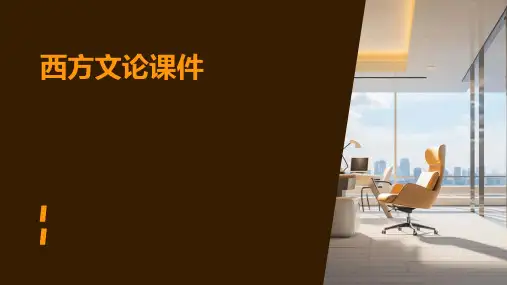
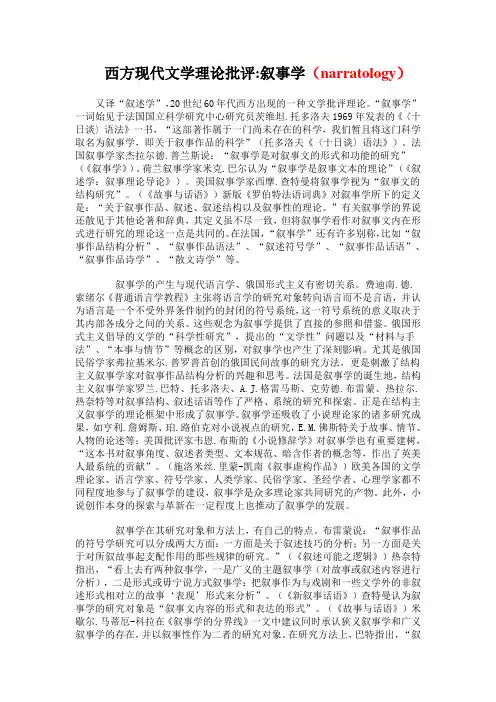
西方现代文学理论批评:叙事学(narratology)又译“叙述学”,20世纪60年代西方出现的一种文学批评理论。
“叙事学”一词始见于法国国立科学研究中心研究员茨维坦.托多洛夫1969年发表的《〈十日谈〉语法》一书,“这部著作属于一门尚未存在的科学,我们暂且将这门科学取名为叙事学,即关于叙事作品的科学”(托多洛夫《〈十日谈〉语法》)。
法国叙事学家杰拉尔德.普兰斯说:“叙事学是对叙事文的形式和功能的研究”(《叙事学》)。
荷兰叙事学家米克.巴尔认为“叙事学是叙事文本的理论”(《叙述学:叙事理论导论》)。
美国叙事学家西摩.查特曼将叙事学视为“叙事文的结构研究”。
(《故事与话语》)新版《罗伯特法语词典》对叙事学所下的定义是:“关于叙事作品、叙述、叙述结构以及叙事性的理论。
”有关叙事学的界说还散见于其他论著和辞典,其定义虽不尽一致,但将叙事学看作对叙事文内在形式进行研究的理论这一点是共同的。
在法国,“叙事学”还有许多别称,比如“叙事作品结构分析”、“叙事作品语法”、“叙述符号学”、“叙事作品话语”、“叙事作品诗学”、“散文诗学”等。
叙事学的产生与现代语言学、俄国形式主义有密切关系。
费迪南.德.索绪尔《普通语言学教程》主张将语言学的研究对象转向语言而不是言语,并认为语言是一个不受外界条件制约的封闭的符号系统,这一符号系统的意义取决于其内部各成分之间的关系。
这些观念为叙事学提供了直接的参照和借鉴。
俄国形式主义倡导的文学的“科学性研究”,提出的“文学性”问题以及“材料与手法”、“本事与情节”等概念的区别,对叙事学也产生了深刻影响。
尤其是俄国民俗学家弗拉基米尔.普罗普首创的俄国民间故事的研究方法,更是刺激了结构主义叙事学家对叙事作品结构分析的兴趣和思考。
法国是叙事学的诞生地,结构主义叙事学家罗兰.巴特、托多洛夫、A.J.格雷马斯、克劳德.布雷蒙、热拉尔.热奈特等对叙事结构、叙述话语等作了严格、系统的研究和探索。
正是在结构主义叙事学的理论框架中形成了叙事学。
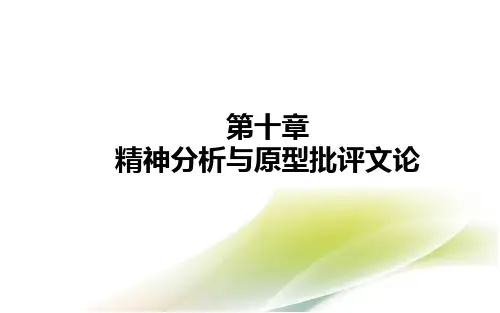
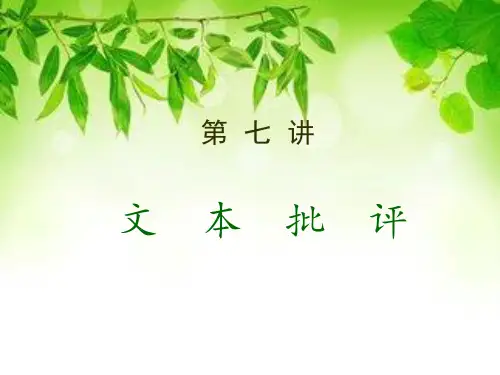
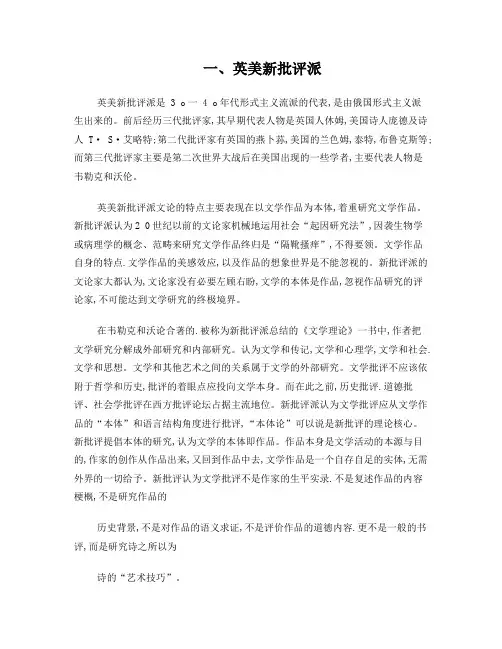
一、英美新批评派英美新批评派是 3 o一 4 o年代形式主义流派的代表,是由俄国形式主义派生出来的。
前后经历三代批评家,其早期代表人物是英国人休姆,美国诗人庞德及诗人T· S·艾略特;第二代批评家有英国的燕卜荪,美国的兰色姆,泰特,布鲁克斯等;而第三代批评家主要是第二次世界大战后在美国出现的一些学者,主要代表人物是韦勒克和沃伦。
英美新批评派文论的特点主要表现在以文学作品为本体,着重研究文学作品。
新批评派认为2 0世纪以前的文论家机械地运用社会“起因研究法”,因袭生物学或病理学的概念、范畴来研究文学作品终归是“隔靴搔痒”,不得要领。
文学作品自身的特点.文学作品的美感效应,以及作品的想象世界是不能忽视的。
新批评派的文论家大都认为,文论家没有必要左顾右盼,文学的本体是作品,忽视作品研究的评论家,不可能达到文学研究的终极境界。
在韦勒克和沃论合著的.被称为新批评派总结的《文学理论》一书中,作者把文学研究分解成外部研究和内部研究。
认为文学和传记,文学和心理学,文学和社会.文学和思想。
文学和其他艺术之间的关系属于文学的外部研究。
文学批评不应该依附于哲学和历史,批评的着眼点应投向文学本身。
而在此之前,历史批评.道德批评、社会学批评在西方批评论坛占据主流地位。
新批评派认为文学批评应从文学作品的“本体”和语言结构角度进行批评,“本体论”可以说是新批评的理论核心。
新批评提倡本体的研究,认为文学的本体即作品。
作品本身是文学活动的本源与目的,作家的创作从作品出来,又回到作品中去,文学作品是一个自存自足的实体,无需外界的一切给予。
新批评认为文学批评不是作家的生平实录.不是复述作品的内容梗概,不是研究作品的历史背景,不是对作品的语义求证,不是评价作品的道德内容.更不是一般的书评,而是研究诗之所以为诗的“艺术技巧”。
新批评之新就在于它不同于以往的各种批评,批评的对象和重点已经从作品以外的历史背景,作家生平,作品的故事梗概等,移到了作品本身。
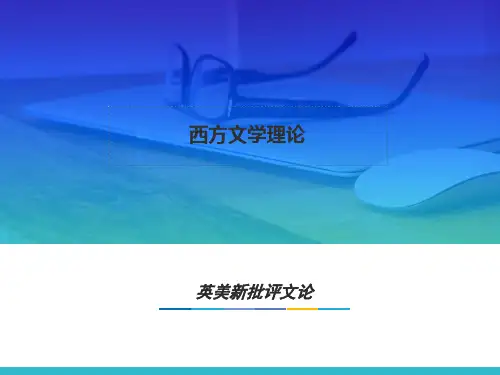
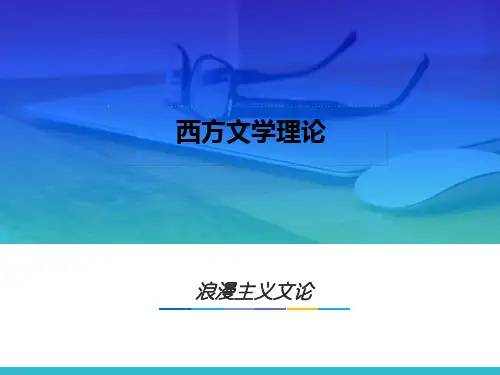
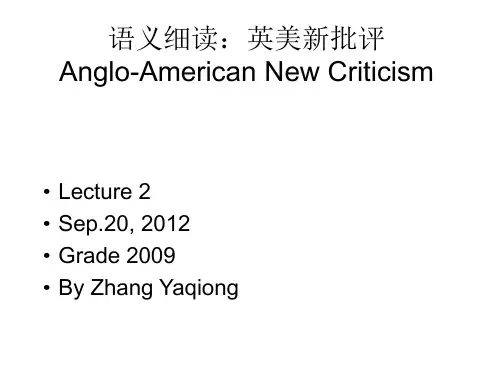
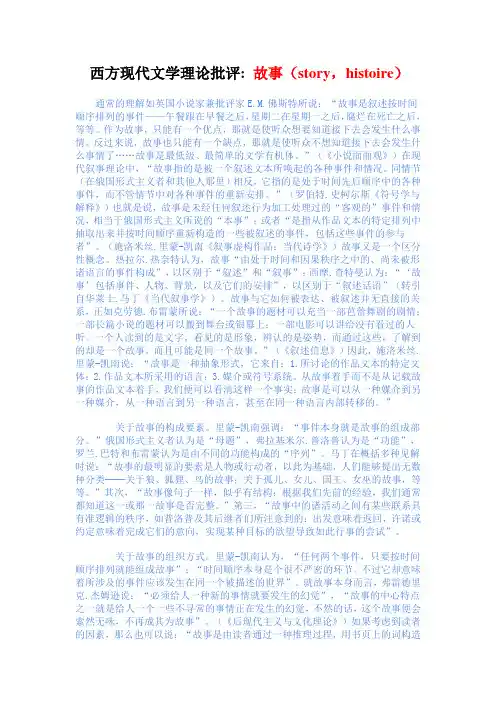
西方现代文学理论批评: 故事(story,histoire)通常的理解如英国小说家兼批评家E.M.佛斯特所说:“故事是叙述按时间顺序排列的事件——午餐跟在早餐之后,星期二在星期一之后,腐烂在死亡之后,等等。
作为故事,只能有一个优点,那就是使听众想要知道接下去会发生什么事情。
反过来说,故事也只能有一个缺点,那就是使听众不想知道接下去会发生什么事情了……故事是最低级、最简单的文学有机体。
”(《小说面面观》)在现代叙事理论中,“故事指的是被一个叙述文本所唤起的各种事件和情况。
同情节(在俄国形式主义者和其他人那里)相反,它指的是处于时间先后顺序中的各种事件,而不管情节中对各种事件的重新安排。
”(罗伯特.史柯尔斯《符号学与解释》)也就是说,故事是未经任何叙述行为加工处理过的“客观的”事件和情况,相当于俄国形式主义所说的“本事”;或者“是指从作品文本的特定排列中抽取出来并按时间顺序重新构造的一些被叙述的事件,包括这些事件的参与者”。
(施洛米丝.里蒙-凯南《叙事虚构作品:当代诗学》)故事又是一个区分性概念。
热拉尔.热奈特认为,故事“由处于时间和因果秩序之中的、尚未被形诸语言的事件构成”,以区别于“叙述”和“叙事”;西摩.查特曼认为:“‘故事’包括事件、人物、背景,以及它们的安排”,以区别于“叙述话语”(转引自华莱士.马丁《当代叙事学》)。
故事与它如何被表达、被叙述并无直接的关系,正如克劳德.布雷蒙所说:“一个故事的题材可以充当一部芭蕾舞剧的剧情;一部长篇小说的题材可以搬到舞台或银幕上;一部电影可以讲给没有看过的人听。
一个人读到的是文字,看见的是形象,辨认的是姿势,而通过这些,了解到的却是一个故事,而且可能是同一个故事。
”(《叙述信息》)因此,施洛米丝.里蒙-凯南说:“故事是一种抽象形式,它来自:1.所讨论的作品文本的特定文体;2.作品文本所采用的语言;3.媒介或符号系统。
从故事着手而不是从记载故事的作品文本着手,我们便可以看清这样一个事实:故事是可以从一种媒介到另一种媒介,从一种语言到另一种语言,甚至在同一种语言内部转移的。

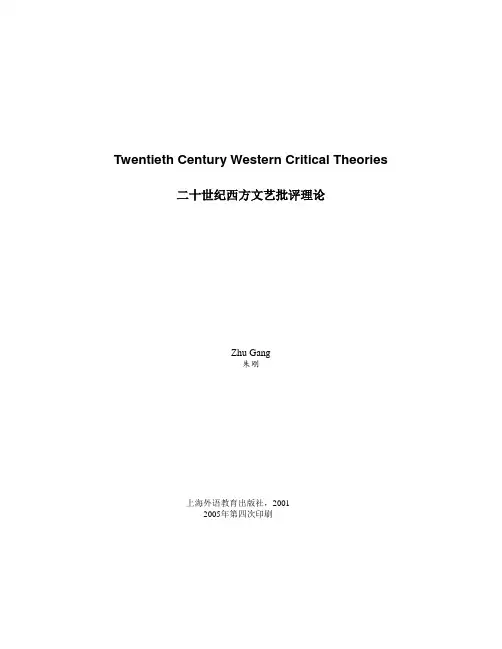
Twentieth Century Western Critical Theories 二十世纪西方文艺批评理论Zhu Gang朱刚上海外语教育出版社,20012005年第四次印刷IntroductionThis sourcebook comes out of a need for basic texts of the twentieth century Western literary and cultural theories. The current volume is meant solely for pedagogical purposes, i.e., for graduate courses on contemporary Western literary theory. Each unit forms a critical “school” (in the broad sense), starting with a critical survey of the school under discussion. For each critic, the sourcebook provides a sketchy introduction, a selection of the critic‟s work, some necessary notes to the texts (reduced to the minimum for a smooth reading.), followed by study questions based on the essay selected for better understanding and class discussion, and finally books and articles recommended for further reading.The book chooses to examine in a roughly chronological order some major Western critical theories of the twentieth century, from Russian Formalism in the early decades to, for instance, the Cultural Studies in the nineties. In addition to a close reading of some carefully selected texts and a survey of current knowledge in this field, the course seeks to introduce students to the major approaches to literature, to show what kind of knowledge is involved and what forms of inquiry exist in this area, how different means of analysis are used, and what their strengths and weaknesses are.The chief objective of the book is to raise the students‟ awareness of the imp ortance of being critical and of the critical theory, discuss with them some influential speculations on and critical approaches to literature, and use them in textual analysis. It will concentrate on a number of questions, such as the locus of literary meaning, the status of the text, the role of the reader, the function of language in literary exegesis, the referentiality of literature, and the relation of literature and society. These questions are of general interest to the students of literature, and of special help to MA students working on their dissertation.The selection of critics (the so-called “canon”) has been made on the bases of their representative character and their availability in Chinese university libraries. The works selected are among the most discussed by Chinese literary scholars and are helpful to students in interpreting literary texts. The assortment of critics into schools is unavoidably arbitrary. Barthes, for instance, should be more properly put under “Deconstruction”, and Said may also belong to “Cultural Studies.” The best policy is to pay more attention to the ideas expressed in the essays than to the labels assigned them. Owing to limits of space, the selections are too short, and the notes too scanty, to ensure good understanding. It is recommended that MA students who are going to write on theory or Ph.D. students of literature read the original work in its entirety.To understand our field of inquiry, a concise, tentative definition of terminology is necessary at the outset, however insufficient any such definition may seem to be today.First and foremost, what is literature? The question is extremely difficult to answer since literature seems to include everything verbally or orally recorded. But this is an important question because contemporary critical theory started with efforts at such a definition. That definition is a negative one: i.e., what is it that sets literature apart from non-literature? In other words, contemporary literary theory started with identifying specific qualities that make a piece of work literary, and all contemporary approaches to literature are answers, in one way or another, to the question of what literature is.Next, what is “theory”? As a field of intellectual inquiry, theory may be taken to be “a body of generalizations and principles, or an ideal or hypothetical set of facts and circumstances, developed in association with practice in a field of activity and forming its content as an intellectual discipline.” In other words, “theory” deals with things on abstract level (generalizations and principles), not in their concrete forms, though this abstraction is based on the actual practices. For instance, literary “theory”develops out of interpretation of concrete works of art. I t is an independent “discipline” because it has its own nature, scope of investigation, and methodology, though it is more and more difficult to identify what these really are. Most importantly, “theory” invites criticism and inquiry, itself being “ideal or hypothetical.”What is literary theory then? Simply put, it is “speculative discourse on literature and on practice of literature.” It may include reflections on or analysis of general principles and categories of literature, such as its nature and function; its relation to other aspects of culture; the purpose, procedures and validity of literary criticism; relation of literary text to their authors and historical contexts; or the production of literary meaning.But what is the difference between “literary theory” and “literary criticism?” A most concise answer would be: one is concerned with “theory” while the other “practice.” Wellek in fact defines “criticism” as “study of concrete works of art.” “Criticism,” we might say, includes “describing, interpreting and evaluating the meaning and effect that literary works have for competent but not necessarily academic readers.” Since “criticism” deals with the experience of reading, it is “not exclusively academic, but often personal and subjective.”A similar though in many ways different concept is aesthetics. The discipline is concerned with literature from a “philosophical” point of view, stressing its relation to the general concepts of art, beauty and value. It has limited relevance to practic al literary study or “criticism,” but has strong affinities with “critical theory” as both tend to take the work of art as “autonomous” and look for its specificities.“Scholarship” is a somewhat different concept. It goes beyond the reader‟s experienc e by referring to factors external to this experience, such as the genesis of the work or its textual transmission. It is often too positivistic to be “theoretical,” asking for detachment and rigor of a specialist.Finally, “critical theory” in this bo ok is used in its broad sense, an umbrella term for various critical approaches to literature and culture in the twentieth century. Its narrower sense refers to the Frankfurt School tradition, seen generally as “responses to the specifically emancipatory i nterest that enters the order of aesthetic and social pracitces.” It is to be noted that much of Frankfurt tradition has merged with recent “literary theory” as the “generic term” when the latter becomes more and more “critical” in nature.Some suggestions for how to read critical theory:i. Always keep at an arm‟s length from the theorists and theories. Always read with a critical eye open.ii. Always think of theory in relation to concrete literary works of art and try to use theory in textual interpretation.iii. Always think of theory in terms of the social reality that has produced it. Marxist perspective in this respect turns out to be helpful.The following reference books are recommended for the course. They are anthologies where more relevant texts are to be found, and introductory works on the theories to be discussed. These books may also appear in the “Further Reading.”Anthologies:Adams, Hazard ed. (1971), Critical Theory Since Plato.New York: Harcourt Brace Jovanovich, Inc. Adams, Hazard & Leroy Searle (1986). Critical Theory Since 1965, Tallahassee: University Presses of Florida,Bate, Walter Jackson ed., Criticism: The Major Texts, Harcourt Brace Jovanovich, Publishers, San Diego etc., 1970Borklund, Elmer, Contemporary Literary Critics, 2nd ed., Macmillan Publishers Limited, Hong Kong, 1982Davis, Robert Con eds. (1998) Contemporary Literary Criticism: Literary and Cultural Studies. New York: LongmanFokkema, D.W. & Elrud Kunne-Ibsch (1977). Theories of Literature in the Twentieth Century. London: C. Hurst & CompanyHandy, William J. & Westbrook, Max eds., Twentieth Century Criticism, The Major Statesments, The Free Press, New York, 1974Kaplan, Charles ed., Criticism: The Major Statements, St. Martin‟s Press, New York, 1975Latimer, Dan ed., Contemporary Critical Theory, Harcourt Brace Jovanovich, Publishers, San Diego etc.Lodge, David (1972). 20th Century Literary Criticism, London: Longman Group Ltd.Newton, K. M. (1988). Twentieth-Century Literary Theory, A Reader, London: MacMillan Education Ltd.---(1992) Theory into Practice, A Reader in Modern Literary Criticism. NY: St. Martin‟s P.Rivkin, Lulie & Michael Ryan eds. (1998) Literary Theory: An Anthology. Oxford: Blackwell Publishers Inc.Trilling, Lionel ed., Literary Criticism, An Introductory Reader, Holt, Rinehart and Winston, Inc., New York etc., 1970Introduction:Culler, Jonathan (1997). Literary Theory. Oxford & New York: Oxford UPEagleton, Terry (1985). Literary Theory, An Introduction. Minneapolis: U of Minnesota P.Jefferson, Ann & David Robey eds. (1986) Modern Literary Theory---A Comparative Introduction. New Jersey: Barnes & Noble BooksLeitch, Vincent B (1988). American Literary Criticism, from the 30s to the 80s. New York: Columbia UPSelden, Raman (1989). A Reader’s Guide to Contemporary Literary Theory. New York & London: Harvester WheatsheafSpikes, Michael P. (1997) Understanding Contemporary American Literary theory. Columbia: U of South Carolina PWebster, Roger (1996). Studying Literary Theory, An Introduction. London & New York: Arnold I would like to express my gratitude to the MA and Ph.D. students in my class all these years for their valuable contribution to this book. My thanks go in particular to Ms Zhu Xuefeng, Miss Tang Xiaomen and Miss Shen Xiaoni for their support in the preparation of the manuscript.Z. G.School of Foreign StudiesNanjing UniversityJan. 2001Contents PageIntroduction i Unit 1 Russian Formalism 11. V. Shklovsky, Art as Technique 32. J. Mukarovsky, Standard Language and Poetic Language 93. B. Eik enbaum, The Theory of the “Formal Method” 134. L. Trotsky, The Formalist School of Poetry and Marxism 17 Unit 2 Anglo-American New Criticism 231. T. S. Eliot, Tradition and the Individual Talent 252. W. K. Wimsatt, Jr. and M.C. Beardsley, The Intentional Fallacy 293. The Affective Fallacy 324. C. Brooks, Irony as a Principle of Structure 345. A. Tate, Tension in Poetry 38 Unit 3 Marxist Criticism 431. T. Eagleton, Literature and History 452. G. Lukács, Critical Realism and Socialist Realism 543. R. Williams: Determination 574. F. Jameson, Narrative as a Socially Symbolic Act 615. The Prison-House of Language 65 Unit 4 Psychoanalytical Criticism 691. S. Freud, The Structures of the Mind 712. The Oedipus Complex 783. The Interpretation of Dreams 824. Creative Writers and Daydreaming 845. L. Trilling, Freud and Literature 886. J. Lacan, The Mirror Stage 91 Unit 5 Myth and Archetypal Criticism 961. C. G. Jung, The Principal Archetypes 982. The Concept of the Collective Unconscious 1023. N. Frye, The Archetypes of Literature 106Unit 6 Structuralism 1121. F. de Saussure, Nature of the Linguistic Sign 1142. C. Lévi-Strauss, The Structural Study of Myth 1173. R. Barthes, The Structuralist Activity 1214. T. Todorov, Definition of Poetics 125 Unit 7 Reader Criticism 1291. W. Iser, The Act of Reading 1312. H.R. Jauss, Literary History as a Challenge to Literary Theory 1353. S. Fish, Why No One‟s Afraid of Wolfgang Iser 1384. N.N. Holland, Reading and Identity 1415. D. Bleich, The Subjective Character of Critical Interpretation 145 Unit 8 Deconstruction 1501. J. Derrida, Structure, Sign, and Play 1522. Différance 1553. J. Hillis Miller, The Critic as Host 1584. A. P. Debicki, New Criticism and Deconstruction 1635. M. H. Abrams, The Deconstructive Angel 166 Unit 9 Feminist Criticism 1701. T. Moi, Sexual/ Textual Politics 1722. E. Showalter, A Literature of Their Own 1763. Representing Ophelia 1804. J. Kristeva, About Chinese Women 185 Unit 10 New Historicism 1921. M. Foucault, The Structures of Punishment 1942. S. Greenblatt, The Improvisation of Power 1973. J. Tompkins, Sentimental Power 2014. N. Armstrong and L. Tennenhouse, Representing Violence 206 Unit 11 Post-Colonial Studies 2121. A. Gramsci, The Prison Notebooks 2142. F. Fanon, Black Skin White Masks 2173. E. Said, Orientalism 2204. G. Viswanathan, Masks of Conquest 224 Unit 12 Gender Studies 2301. V. L. Bullough, Homosexuality, A History 2322. A. Jagose, Queer Theory, An Introduction 2363. M. Wittig, One Is Not Born a Woman 2394. E. K. Sedgwick, Epistemology of the Closet 2435. J. Butler, Gender Trouble 246Unit 13 Cultural Studies 2521. R. Hoggart, The Uses of Literacy 2542. S. Hall, Cultural Studies: Two Paradigms 2573. R. Williams, The Future of Cultural Studies 2614. M. Gottdiener, Disneyland: A Utopian Urban Space 2655. D. Wright, Racism in School Textbooks 271Unit 1 Russian FormalismIn the heyday of high modernism emerged a group of college students and young faculty in Moscow and Petersburg, Russia, whose interest was claimed to be literature per se. They were few in number, but their unmistakable insistence on the ideal status of literary study and stubborn pursuit for its realization has marked the beginning of a new era, and produced profound influence on the subsequent development of contemporary Western critical theory.It is generally believed that Formalism started in 1914 when Viktor Shklovsky publis hed “The Resurrection of the Word,” and ended with his essay “A Monument to Scientific Error” in 1930. Organizationally the formalists centered around two different though interrelated groups. One was “The Society for the Study of Poetic Language” (Opojaz), founded in 1916 by Shklovsky, Boris Eikhenbaum, Yury Tynyanov and others, whose interest was the general principles governing literature and distinguishing it from other forms of verbal expression. The other group was the Moscow Linguistic Circle, founded in 1915 by linguists like Roman Jakobson, which based literary study on linguistics by insisting on the differentiation between poetic and practical language.In spite of the apparent differences in their theoretical assumptions and critical practice, the two groups share one thing in common, namely, to “place the study of literature on a scientific footing by defining its object and establishing its own methods and procedures.” In other words, they were united in an effort to find the internal laws and principles that make a piece of literature literary, or the FORM of literature (hence the label of “formalism”, though Eikhenbaum for political reasons would rather prefer the word “specificity”) (Bennett 1979: 10).“Form” is a negative word, met hodologically, if not ideologically. That is, the formalists argued at the beginning for a strict separation of form and content and made repeated efforts to discredit the latter as a proper object of literary study by concentrating exclusively on the former. This radical separation posed difficult problems, theoretical as well as ideological, for the later formalists, and forced them to make compromises. The former “extra-aesthetic” materials (historical, biographical, sociological, or psychological) were treated as quasi-formal and put back again into the category of “form” in terms of foreground/ background. Here content was called upon only as a means of foregrounding form, and therefore had lost the value of its own ontological existence.For Shkl ovsky, there must be a quality which made form “formal” or literature “literary.” Here he and other formalists faced a difficult task of defining the peculiarity of literature. This peculiarity had been talked about ever since Aristotle in vague terms like “poetry” or “work of art,” simply because it seemed to defy any concrete explication. But for the formalist a concrete and unmistakable concept had to be found, so that the object of discussion (literature) might be put in a more clearly definedtheoretical framework. Shklovsky made a wise breakthrough by turning to language, as literature is basically a verbal art. He argued that literature differs from non literature for a quality called “literariness,” (though other formalists such as the Muscovites wou ld express it in different terms) manifested in its peculiar use of language, as “the language of poetry is ... a difficult, roughened, impeded language.” It is to be noted that this does not mean “poetic” language is necessarily a difficult language. The emphasis here, Shklovsky argued, is on the process of experience rather than on its final product, “the process of perception is an aesthetic end in itself and must be prolonged.”A.S. Pushkin and Maxim Gorky reversed the traditional literary/ ordinary language and therefore “roughened” their language by intentionally making it easier (Lemon & Reis 1965: 22, 12). Similar cases are numerous in different literatures. The Chinese poets in Tang Dynasty such as Li Po pushed for a plain and terse poetic language as a reaction to the dominant ornate poetic style. Similarly, William Wordsworth and Samuel Taylor Coleridge in the English Romanticism used “common language of the common people” for the “spontaneous overflow” of feelings as against the mannerism of the proceeding century.What follows then is the means by which this “literariness” is to be achieved. The formalists started with verbal art, but for a general theory of “specificity” applicable to all forms of art (painting, dancing, photography, architecture, etc.), they had to come to terms with a more universal principle for the “artfulness” of art. Hence the concept of “defamiliarization” (It is said that Shklovsky originally used “OCTPAHHEИE,” or “estrangement” in Russian. But the typesetter mistakenly turned the word into “OCTPAHEИE,” meaning “sharpening,” a beautiful mistake as it now comes to mean “to defamiliarize so as to sharpen”).Shklovsky may not be the first to raise the idea of defamiliarization, P.B. Shelley for instance says in “A Defence of Poetry” that poetry “makes familiar objects be as if they were not familiar.” But it is the Formalists who first made it, by a systemati c account, a poetic principle.If the Opojaz critics looked for “literariness” in the process of reading experience with individual texts, the Moscow linguists turned to more concrete rhetorical devices in structure, rhyme and rhythm for “poeticity.” Roman Jakobson, for instance, in “The Metaphoric and Metonymic Poles” believes that linguistic signs may be clustered around the poles of metaphor and metonymy. Realism in its emphasis on reflection is more metonymic while the avant guard literature is more metaphorical, or poetical.There is one important difference, however, between the Opojaz critics and their linguistic counterparts. While Shklovsky took “laying bare devices” at the expense of all the other literary constituents, Jakobson and Muk arovsky tried to be more inclusive in their idea of “foreground/ background”: a work of art is constituted not by the sheer number of devices, but by devices arranged in a hierarchy. In order to “foreground” a temporarily stable “dominant device,” all the other components of the work have to be present and work together. While Shklovsky finds it hard to account for change in literary form since this form is mechanical and static, and an increased number of devices would eventually lead to the disappearance of any noticeable device, the dynamic network of literary work proposed by the Russian linguists generates a theory of literary historiography: any change in literature is explained by the rearrangement of literary device, with the obsolete device retreating into the background to be foregrounded again, in a different form perhaps, in the future.Later Opojaz critics tried to redress the error they had made. Shklovsky, for instance, talks about literary history in terms of the relation of literary forms: the hegemonic form takes on the traces of the previously dominant form, which may expect to win back the dominance again. Here Shklovsky to a certain extent solves the problem of defamiliarization eventually turned into automatization. Tynyanov also t alks about the change in literary form in terms of “breaks”: literary forms replace one another more by struggle and breakthroughs than by direct inheritance. The idea is interesting because it in a way anticipates Thomas S. Kuhn‟s idea of paradigm shifts and Michel Foucault‟s idea of history. The idea of breakthrough may also account for the particular period when Russian Formalism flourished, a period in which Russian literature tried to break away from the European literary tradition, and Russian criticism to deviate from symbolism, realism, and naturalism.The most severe criticism of Formalism came from Marxism. Trotsky‟s remark that “the form of art is, to a certain and very large degree, independent, but the artist who creates this form, and the spectator who is enjoying it, are not empty machines” is a valid and forceful criticism. Bakhtin was also keen to point out that “if, when we isolate the ideological object, we lose sight of the social connections which penetrate it (of which it is the most subtle manifestation), if we detach it from the system of social interaction, then nothing of the ideological object will remain” (Bakhtin & Medvedev 1985: 77). The formalist idolization of an autonomous text was later described by Fredric Jameson as f alling into the “prison house of language.” In the same light, the British Marxist Terry Eagleton deconstructs the idea of an ordinary language shared by the whole community, since “[any] actual language consists of a highly complex range of discourses, differentiated according to class, region, gender, status and so on” (Eagleton 1985: 5). Even formalists themselves realized that isolation of literariness might create more problems than they claimed to have solved. Tynyanov, for instance, observed in 1924 that it was almost impossible to make an absolute definition of literature; Eikhenbaum also admitted in 1929 that the relation between and the function of the constituents of literature were changing all the time (Todorov 1988: 86).Erroneous as it was and notorious as it has now become, the heritage of Formalism is too large to be overlooked. The post-structuralist Stanley Fish redefines formalism in terms of “beliefs,” and the sixteen formalistic beliefs he has listed cover almost every aspect of our life (Fish 1989: 6). Fokkema also observes that almost every literary theory in Europe is inspired by Formalism in one way or another (Fokkema & Kunne-Ibsch 1977:11). After the most dismantling attack on formalism in the seventieth and eightieth, more and more critics realize today that “we find in the activity of the Opojaz group the challenge in their trying to make out of literary studies a homogeneous domain... As we observe, they succeeded to a very large extent. For this reason alone, it is important to accept the most enriching part of their heritage and to continue it, rather than to grasp its weak points and to criticize them. The latter is always the easiest task” (Matejka & Pomorska, 1978: 279)There are many ways to account for the rise of Russian formalism. The turbulent years under Tsarism had turned some literary scholars away from any political commitment, for instance; the European influences such as aestheticism, intuitionism and Saussurean linguistics had found ready followers in Russia to the ivory tower of language; and the early twentieth century scientism had a special appeal to the Formalists. Yet one is not to forget the Russian critical heritage which had “foregrounded” Formalism. “Formalism was, it is true, the first critical m ovement in Russia which attacked in systematic fashion the problems of rhythm and meter, of style and composition. But the interest in literary craft was not in itself a novel phenomenon in Russian critical thought...a rich indigenous tradition of form-con sciousness [goes] back as far as the Middle Ages” (Erlich 1965: 20). Russian Formalism formally ended in early 1930s, but Jakobson and his colleagues went on with their research, first in Prague and then in the US. In spite of the apparent similarities between Formalism and Anglo-American New Criticism, there is little evidence of mutual influence. However, RenéWellek, a major New Critic, collaborated with Jakobson in the Prague group in the 1930s. Formalism did not attract any critical attention from the Western academia until Erlich‟s publication of Russian Formalism, History - Doctrine in 1955 and Todorov‟s publication in 1965 of an anthology of Russian formalists, Theory of Literature, which enhanced the awareness of language and linguistic model for the French structuralists. Formalism had strong impact on the structuralism in the Soviet Union in the 1960s, especially the Tartu-Moscow group. Similar impact was also found in Czechoslovakia and Poland.Art as Technique(Viktor Borisovich Shklovsky, 1893-1984)Shklovsky is the leading Russian formalist theoretician and novelist. Graduate from St.Petersburg U and teacher at the Institute of Art History, he organized Opojaz andbecame its charter member, having “touched most of the fundamentals of Formalisttheory” and being “often the first to define a problem, and frequently [pointing] to itssolution.” Within a decade he proposed some of the most enduring concepts ofFormalism, such as defamiliarization (ostranenie), literariness, story/ plot (fabula/siuzhet), material/ device and laying bare of device. He is best remembered for hisanalysis of plot composition in terms of repetition, tautology, parallelism, double-plotting, opposition and false ending. From 1930s, he made more conventionalsociological studies on Tolstoy, and re-emerged in the 1960s with the reprints of hisearlier works and memoirs of Opojaz. “Art as Technique” (1917), a primary documentof the early Formalists, is often regarded as its manifesto. It “announces a break withth e only other …aesthetic‟ approach available at that time and in that place,” and “offersa theory of both the methodology of criticism and the purpose of art” by highlightingsome concepts central to the theoretical stance of the school in general, such asdefamiliarization and the distinction between poetic and ordinary language.“Art is thinking in images.” This maxim, which even high school students parrot, is nevertheless the starting point for the erudite philologist who is beginning to put together some kind of systematic literary theory. The idea, originated in part by Potebnya, has spread. “Without imagery there is no art, and in particular no poetry,” Potebnya writes. And elsewhere, “poetry, as well as prose, is first and foremost a special way of thinking and knowing.”Poetry is a special way of thinking; it is precisely, a way of thinking in images, a way which permits what is generally called “economy of mental effort,” a way which makes for “a sensation of the relative ease of the process.” Aesthetic feeling is the reaction to this economy. This is how the academician Ovsyaniko-Kulikovsky, who undoubtedly read the works of Potebnya attentively, almost certainly understood and faithfully summarized the ideas of his teacher. Potebnya and his numerous disciples consider poetry a special kind of thinking--- thinking by means of images; they feel that the purpose of imagery is to help channel various objects and activities into groups and to clarify the unknown by means of the known.Nevertheless, the definition “Art is thinking in images,” which means (I omit the usual middle terms of the argument) that art is the making of symbols, has survived the downfall of the theory which supported it. It survives chiefly in the wake of Symbolism, especially among the theorists of the Symbolist movement.Many still believe, then, that thinking in images---thinking, in specific scenes of “roads and landscape” and “furrows and boundaries”1--- is the chief characteristic of 1An illusion to Vyacheslav Ivanov‟s Furrows and Boundaries (Moscow, 1916), a major statement of Symbolist theory.。
西方现代文学理论批评:形式主义批评(formalist criticism)英美批评家通常用这个术语指称“新批评派”的理论与实践。
1951年克林思.布鲁克斯在论辩中直言不讳地承认新批评派是“形式主义批评家”,“主要关注的是作品本身”。
他说:“为了对作品本身作出评价,形式主义批评家提出两点假设:一、假定作者的真正意图就是他在作品中实际表现出的意图;也就是说,只有作者在作品中实现了的意图才能算数,至于作者写作时怎样设想,或者作者现在回忆起当初如何设想,都不能作为依据;二、假定阅读作品的是一位理想读者,也就是说,不去注意不同读者对作品的各种不同的理解,而是努力找到一个中心立足点,以它为基准来研究诗歌或小说的结构。
”(《形式主义批评家》)威尔弗雷德.L.古尔灵等则说:“形式主义批评的唯一目的是发现和解释文学作品的形式。
这种批评方法把文学本身看作是独立的,因此文学作品以外的考虑,如作者的生平、作者所处的时代、作品对社会、政治、经济和心理等方面的意义,相对来说是不重要的。
”“形式主义批评家所研究的核心问题可以简述为:文学作品是什么?文学作品的形式和效果是怎样的?这些形式和效果是如何实现的?这些问题的答案都应该直接来自作品文本。
”(《文学批评方法手册》)这种批评被认为是“当代最有影响的批评模式”。
(魏伯.司各特《文艺批评的五种模式》)西方现代文学理论批评:俄国形式主义(Russian Formalism)“形式主义一词从它的对手加给它的贬义来说,指的是1915年到1930年期间在俄国出现的一种文学批评潮流。
形式主义理论是结构语言学的起始,至少是布拉格语言学会所代表的潮流的起始。
”(茨维坦.托多洛夫《俄苏形式主义文论选编说明》)这个批评潮流是由维克托.什克洛夫斯基、鲍里斯.艾亨鲍姆、尤里.图尼亚诺夫、奥西普.勃里克等人组成的彼得格勒诗歌语言研究会和由罗曼.雅各布森、鲍里斯.托马舍夫斯基等人组成的莫斯科语言学学会来推动的。